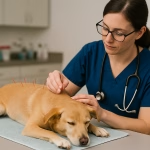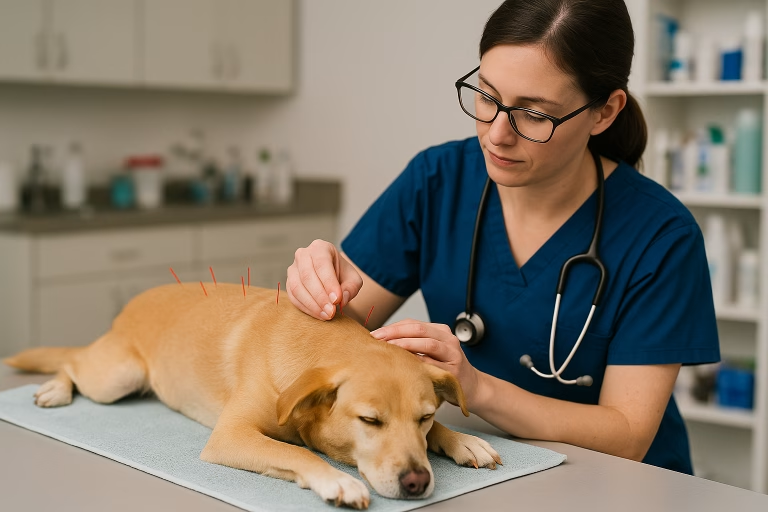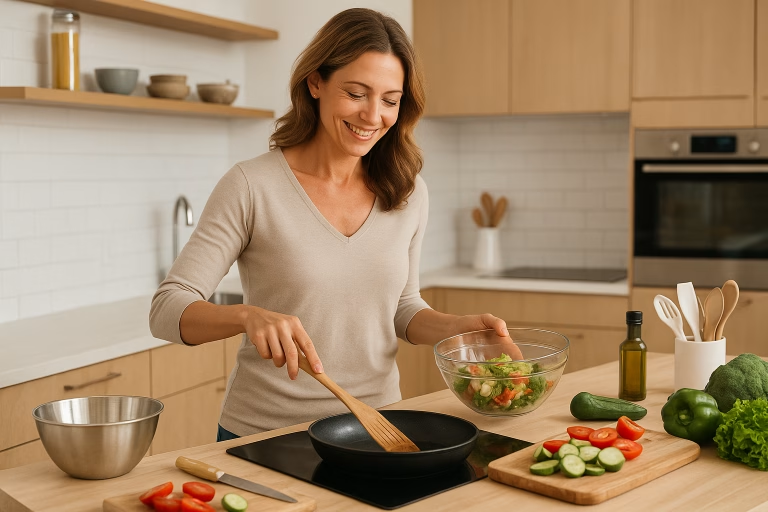
A young couple meets with a fertility specialist to discuss safe, pharmacist-recommended fertility supplements and lifestyle strategies for conception.
I. Introduction: Why listen to a pharmacist?
Trying to conceive (TTC) can feel like a maze of products, opinions, and acronyms. Pharmacists live at the intersection of evidence and everyday use—we’re trained to evaluate clinical data and to translate it into clear, safe, step-by-step guidance you can apply at home.
What this guide covers. We’ll focus on home-use tools and over-the-counter (OTC) supplements with the most accessible evidence for improving your chances of conception when certain conditions are met. We’ll highlight exactly who benefits, how to use each product correctly, how long to try, common pitfalls, safety, and when to escalate to a fertility specialist.
How strong is the evidence? Throughout, you’ll see quick notes on evidence quality (e.g., Cochrane Review, randomized controlled trials, systematic reviews). For example, a recent Cochrane analysis concluded that timing intercourse using urine ovulation tests (OPKs) probably increases pregnancy and live-birth rates in women under 40 who’ve been trying <12 months, versus intercourse without ovulation prediction. We’ll unpack what that means—and how to do it right—in Section II. Cochrane+2Cochrane+2
When should you see a clinician? In the absence of red flags, major societies advise evaluation after 12 months of trying if you’re <35 years old, or after 6 months if you’re ≥35—sooner if you have irregular cycles, known conditions (e.g., endometriosis), or other concerning symptoms. We’ll repeat these thresholds in each section so you always know the “try at home vs. seek care” boundary. ASRM+2ASRM+2
Both partners matter. Male-factor issues are involved in roughly 40–50% of infertility cases (solely or in combination). That’s why one of our Top 5 focuses specifically on male antioxidants—and why baseline semen analysis and urology/REI follow-up are part of our action plans. NCBI+1
What made the Top 5 (and why). After weighing quality of evidence, safety, practicality, cost, and pharmacist counseling experience, these are the five fertility aids we’ll cover in depth:
- Urine ovulation predictor kits (OPKs) — best-supported home tool to time the fertile window. Cochrane
- Myo-inositol (± D-chiro-inositol) for PCOS/oligo-ovulation — improves ovulation and some ART parameters in selected patients. (Section III)
- Coenzyme Q10 (CoQ10) for ovarian aging/DOR — mechanistic rationale with growing clinical data, especially as ART pre-treatment. (Section IV)
- Male antioxidants (L-carnitine ± NAC/CoQ10) — evidence for semen-parameter improvements; how and when to use. (Section V)
- Fertility-friendly lubricants — avoid motility-suppressing lubes; choose FDA-cleared “gamete, fertilization & embryo compatible” products. (Section VI) FDA Access Data+2FDA Access Data+2
What this guide does not do. It does not replace individualized medical care, medications like letrozole/clomiphene for anovulation, or work-ups for conditions such as tubal disease, diminished ovarian reserve, thyroid disorders, hyperprolactinemia, endometriosis, or significant male-factor infertility. (We’ll flag red-flags and referral points in every section.) PubMed
How to use this article.
- Skim the “Who benefits” and “How to use” subsections to see if a tool fits your situation.
- Follow the step-by-step pharmacist instructions and time-to-benefit guidance (often 3–6 cycles for many OTC approaches).
- Use the comparison tables and checklists later in the article to build a personalized, evidence-based plan and to know exactly when to escalate.
Disclaimer (read this first): This article is for education only and is not medical advice. Always consult your clinician before starting or combining fertility supplements—especially if you’re ≥35, have irregular cycles, known medical conditions, take prescription medications, or have abnormal semen parameters. If you’ve been trying ≥12 months (<35) or ≥6 months (≥35) without success—or sooner if you have symptoms such as amenorrhea, severe pelvic pain, galactorrhea, or recurrent pregnancy loss—seek a personalized evaluation with a fertility specialist. ASRM+1
II. Fertility Aid #1 — Urine Ovulation Predictor Kits (OPKs)
When couples begin trying to conceive, timing is everything. You can only get pregnant during the few days surrounding ovulation—the release of an egg from the ovary. Knowing exactly when that happens can double your chances of success each cycle.
Pharmacists often recommend urine ovulation predictor kits (OPKs) as the first-line, evidence-based tool to identify this fertile window.
What OPKs Are and How They Work
OPKs detect the surge in luteinizing hormone (LH) that occurs about 24–36 hours before ovulation. This LH surge signals the body that ovulation is imminent, helping you time intercourse during the 1–2 days when conception is most likely.
There are two main types:
- Strip tests – inexpensive, require visual interpretation (two lines).
- Digital kits – display a clear result (e.g., smiley face) but cost more per cycle.
These tests are widely available at pharmacies, supermarkets, and online. Reliable brands include Clearblue® and Easy@Home®, but any FDA-registered LH test is acceptable.
Pro tip from pharmacists: Always check the expiration date and store kits in a cool, dry place. Humidity and heat can alter test accuracy.
Evidence Snapshot: What Studies Show
A Cochrane Review (2020) found that timing intercourse based on urinary LH detection “probably increases pregnancy and live-birth rates” compared with no prediction methods in women under 40 trying for <12 months.
- Relative risk (RR) for pregnancy: 1.36 (95% CI 1.02–1.81)
- Relative risk for live birth: 1.28 (95% CI 1.09–1.49)
(Cochrane Database of Systematic Reviews)
This makes OPKs one of the few non-prescription fertility aids backed by moderate-certainty evidence. Other systematic reviews have confirmed these findings, noting their usefulness for women with regular cycles and no known infertility conditions.
(Oxford Academic – Human Reproduction Update)
How to Use OPKs Correctly (Step-by-Step)
- Determine your typical cycle length.
If your cycle averages 28 days, ovulation likely occurs around day 14. Begin testing around day 10 (cycle day 1 = first day of your period). - Test once daily at the same time.
Midday (10 a.m.–2 p.m.) urine is best—LH often peaks after waking. Reduce fluid intake for two hours before testing. - Interpret the result:
- Line tests: Two lines = positive when the test line is as dark or darker than the control line.
- Digital tests: “Smiley” or “Peak” symbol means ovulation is expected within 24–36 hours.
- Time intercourse:
Have intercourse the day of a positive result and for the next two days. These are your most fertile days. - Optional confirmation:
Combine OPK data with basal body temperature (BBT) or progesterone lab tests to confirm ovulation occurred.
Pharmacist tip: If you’re unsure how to read faint lines, stick to digital kits for clarity. For cost savings with frequent testing, use strips for early tracking and confirm with a digital test.
Common Pitfalls and Special Cases
- Irregular cycles or PCOS:
Women with polycystic ovary syndrome (PCOS) often have consistently elevated LH levels, leading to false positives. Pairing OPKs with myo-inositol therapy (see Section III) may help regulate ovulation. - Postpartum or after stopping contraception:
Ovulation may be delayed or unpredictable; wait until cycles stabilize. - Medications:
Fertility drugs containing LH or hCG (e.g., hMG, Ovidrel®) may cause false positives. - Hydration:
Overhydration before testing can dilute LH levels and yield false negatives.
Comparing OPK Options
| Type | Examples | Accuracy | Approx. Cost (per cycle) | Pros | Cons |
|---|---|---|---|---|---|
| Test strips | Easy@Home®, Wondfo® | 97–99% | $10–$20 | Cheap, quick | Manual interpretation |
| Digital kits | Clearblue® Digital | 99% | $25–$45 | Clear “peak” display | Costlier |
| Advanced monitors | Clearblue® Fertility Monitor | 99% | $100+ | Tracks multiple hormones (LH + E3G) | Expensive, not needed for all |
For verified product lists, visit FDA’s database of over-the-counter fertility devices.
When to Seek Medical Evaluation
See your clinician if:
- You’ve used OPKs correctly for 6 months (≥35 years) or 12 months (<35 years) without success.
- Your cycles are <21 days or >35 days apart.
- You have symptoms like amenorrhea, severe pelvic pain, or abnormal bleeding.
- Your partner has a history of urologic issues or low sperm count.
Summary: Pharmacist’s Takeaway
- Who benefits most: Women under 40 with regular cycles and no diagnosed infertility.
- Time-to-benefit: Usually within 3–6 cycles when used properly.
- Evidence quality: Moderate (Cochrane 2020, Oxford 2021).
- Safety: Excellent—no systemic side effects.
- Pharmacist’s tip: Track results on a fertility app or journal to discuss with your provider if cycles remain anovulatory.
Disclaimer:
Urine ovulation kits are screening tools, not diagnostic devices. False readings can occur in PCOS, perimenopause, or medication use. If you suspect irregular ovulation or have tried for months without success, consult your OB/GYN or fertility specialist. This content is for educational purposes and not a substitute for professional medical advice.
III. Fertility Aid #2 — Myo-Inositol (± D-Chiro-Inositol) for PCOS & Ovulatory Dysfunction
When women struggle with irregular cycles or anovulation, one of the most common culprits is polycystic ovary syndrome (PCOS) — a hormonal and metabolic condition affecting up to 1 in 10 reproductive-age women. Among OTC options, myo-inositol (often combined with a small amount of D-chiro-inositol) stands out as a pharmacist-recommended, evidence-backed supplement to improve ovulation, egg quality, and even metabolic parameters.
What It Is and How It Works
Myo-inositol (MI) is a naturally occurring vitamin-like carbohydrate that acts as a second messenger in insulin and FSH signaling pathways. In PCOS, insulin resistance and abnormal ovarian insulin signaling disrupt normal follicle maturation. MI helps restore insulin sensitivity, rebalance ovarian hormone activity, and promote ovulation.
- Myo-inositol (MI): Improves insulin sensitivity and follicular response.
- D-chiro-inositol (DCI): Supports insulin signaling but in excess may impair oocyte quality.
The physiologic MI:DCI ratio in follicular fluid is about 40:1—a ratio mirrored in many supplement formulations.
Evidence Snapshot: What Studies Show
1. Systematic Reviews & Meta-Analyses
- A 2017 meta-analysis in Gynecological Endocrinology concluded that myo-inositol significantly improved ovulation frequency and menstrual regularity in women with PCOS compared with placebo or metformin monotherapy.
- A 2023 systematic review of 26 randomized controlled trials found that MI supplementation enhanced oocyte quality and clinical pregnancy rates in IVF/ICSI cycles among PCOS patients, with minimal side effects.
- A 2024 update in Human Reproduction Open reported improved metabolic markers (lower fasting insulin and HOMA-IR) and reduced serum testosterone in MI-treated groups, confirming benefit beyond fertility.
2. Compared with Metformin
MI achieved comparable ovulation and pregnancy outcomes with better tolerability (fewer GI side effects) versus metformin, making it a preferred first-line OTC option when a clinician isn’t yet involved.
Pharmacist’s Guide to Dosing & Use
| Formulation | Common Dose | Frequency | Notes |
|---|---|---|---|
| Myo-inositol only | 2 g | Twice daily | Most studied monotherapy dose |
| Myo + D-chiro inositol (40:1 ratio) | MI 2 g + DCI 50 mg | Twice daily | Mimics physiologic ratio |
| Powder packets | 2 g | BID | Mix in water; easier absorption |
| Capsules/tablets | 500–1,000 mg | 2–4 daily | Take with meals |
Duration: Expect improvement in 3–6 cycles. Continue until pregnancy confirmation, unless otherwise advised by your clinician.
When to pair with folate: Many pharmacist-recommended brands add 400–800 µg folic acid, aligning with CDC pre-pregnancy guidance.
✅ Pharmacist tip: Consistency matters more than brand. Choose third-party-tested products (USP-verified, NSF-certified, or from reputable pharmacies).
Who Benefits Most
- Women with PCOS, oligomenorrhea, or anovulatory infertility.
- Those with insulin resistance, elevated AMH, or high LH/FSH ratios.
- Patients planning IVF/ICSI who want to improve oocyte mitochondrial function and reduce oxidative stress.
- Women intolerant to metformin’s GI side effects.
Safety Profile and Interactions
- Generally well-tolerated: Mild GI discomfort, flatulence, or headache are uncommon.
- Drug interactions:
- Safe to combine with metformin (often synergistic).
- No known interference with oral contraceptives or thyroid meds.
- Pregnancy: Preliminary data suggest safety; many clinicians allow continuation through early pregnancy for metabolic support, but confirm individually.
- Caution: Avoid unverified “inositol blends” that don’t disclose MI:DCI ratio—high DCI content may impair egg quality.
Real-World Pharmacist Counseling
- Set expectations: “Myo-inositol is not a magic pill—it takes consistent use for at least 3 months.”
- Combine with lifestyle: Exercise and low-glycemic diet enhance insulin-sensitizing effects.
- Track progress: Use OPKs or apps to monitor return of ovulation.
- Check in: If no ovulation after 6 months, escalate to medical therapy (letrozole/clomiphene).
- Monitor for hypoglycemia if taken with other insulin-lowering agents.
Cost & Product Comparison
| Product Example | Composition | Approx. Monthly Cost | Verified 3rd-Party Testing |
|---|---|---|---|
| Ovasitol® | MI 2000 mg + DCI 50 mg (40:1) | $65 | NSF Certified |
| Theralogix Inositol Complex | MI/DCI (40:1) + Folate | $60 | USP Verified |
| Bulk Myo-Inositol Powder | MI only | $25 | None (buyer beware) |
Outgoing link: ASRM Practice Committee Guidelines on PCOS
Outgoing link: PubMed Meta-Analysis 2023 – Myo-Inositol in PCOS
Outgoing link: NIH Office of Dietary Supplements Inositol Profile
Key Takeaways
- Evidence strength: Moderate–high (multiple meta-analyses, low heterogeneity).
- Primary outcomes: Ovulation frequency ↑, menstrual regularity ↑, metabolic health ↑.
- Who should use: PCOS patients or those with irregular cycles.
- When to stop/escalate: After 6 months without ovulation → discuss Rx options.
- Pharmacist summary: Safe, affordable, and among the most clinically supported OTC fertility supplements available.
Disclaimer:
This information is for educational purposes only and not a substitute for medical advice. Consult a healthcare professional before combining inositol with prescription medications or if you have diabetes, thyroid disorders, or ongoing infertility despite consistent use. Always verify product quality through trusted pharmacy sources.
IV. Fertility Aid #3 — Coenzyme Q10 (CoQ10) for Ovarian Aging & Diminished Ovarian Reserve (DOR)
As women age, their mitochondria—the “batteries” inside every egg cell—gradually lose efficiency, leading to poorer oocyte quality, lower fertilization rates, and higher chances of chromosomal abnormalities.
One supplement pharmacists are increasingly asked about for this issue is Coenzyme Q10 (CoQ10)—a naturally occurring antioxidant and electron-transport cofactor involved in cellular energy production.
Unlike trendy “fertility boosters,” CoQ10 has a clear biochemical rationale and a growing body of clinical data supporting its use in women over 35 or those with diminished ovarian reserve (DOR).
What CoQ10 Is and How It Works
CoQ10 exists in two interchangeable forms:
- Ubiquinone (oxidized) — the more stable, lower-cost form.
- Ubiquinol (reduced) — higher bioavailability but more expensive.
Inside the mitochondria, CoQ10 shuttles electrons during ATP synthesis and protects oocytes from oxidative stress. In aging ovaries, CoQ10 levels decline, contributing to reduced mitochondrial performance and oocyte competence. Supplementation replenishes these levels, potentially improving egg quality, embryo development, and ovarian response to stimulation.
Evidence Snapshot: What Studies Show
1. Systematic Reviews & Meta-Analyses
- Zhang et al., 2023 (Reproductive Biology and Endocrinology):
Women receiving CoQ10 before IVF/ICSI had more retrieved oocytes, better embryo quality, and higher clinical pregnancy rates than controls, particularly among those with poor ovarian response (POR).
👉 Read the study on PubMed - Xu et al., 2024 (Fertility and Sterility):
Meta-analysis of 10 RCTs (n ≈ 900) showed CoQ10 improved fertilization rates by ~12% and clinical pregnancy rates by ~9% in POR/DOR populations, with no increase in adverse events. - Cochrane Style Review 2024 (update pending) concluded that pre-treatment with CoQ10 before ART may enhance ovarian response, though evidence remains moderate-certainty due to small sample sizes.
2. Mechanistic Insights
CoQ10 improves mitochondrial membrane potential, ATP output, and antioxidant enzyme activity in granulosa and oocyte cells.
Animal studies confirm enhanced oocyte maturation rates and reduced apoptosis in CoQ10-supplemented groups.
Pharmacist’s Dosing & Formulation Guide
| Form | Typical Dose | Frequency | Notes |
|---|---|---|---|
| Ubiquinone (standard) | 200 – 600 mg | Once daily with fatty meal | Proven effective; cost-efficient |
| Ubiquinol (enhanced absorption) | 100 – 300 mg | Once daily | Consider for older patients or GI issues |
| IVF protocol pre-treatment | 300 mg/day for 8–12 weeks before stimulation | Used in most RCTs |
Duration: Take for at least 8–12 weeks to cover the folliculogenesis cycle (~90 days).
Administration: Always with meals containing fat to maximize absorption.
✅ Pharmacist Tip: Divide large doses (≥400 mg) into twice-daily dosing to improve GI tolerance.
Who Benefits Most
- Women ≥35 years old seeking conception naturally or via ART.
- Those diagnosed with Diminished Ovarian Reserve (DOR) or Poor Ovarian Response (POR) based on AMH < 1.2 ng/mL or AFC < 5.
- Patients preparing for IVF/ICSI retrieval cycles who want to optimize egg and embryo quality.
- Possibly men with subfertile parameters (see Section V).
Safety & Drug Interactions
Safety: Generally well tolerated. Mild GI upset (~1–3%) is the most common issue.
Potential interactions:
- Antihypertensives / β-blockers: May enhance hypotensive effects.
- Warfarin: Monitor INR; CoQ10 is structurally similar to vitamin K.
- Chemotherapy agents: Consult oncologist before use (post-chemo fertility patients).
Pregnancy & Breastfeeding:
Limited human data; safe in pre-conception phase but discontinue once pregnancy confirmed unless clinically indicated.
See NIH ODS Coenzyme Q10 Fact Sheet for reference.
Cost & Quality Comparison
| Product Example | Form | Dose | Approx. Monthly Cost | Quality Verification |
|---|---|---|---|---|
| Qunol Ubiquinol® | Reduced | 100 mg | $35 – $45 | USP Verified |
| Nature Made® CoQ10 | Ubiquinone | 200 mg | $25 | USP Verified |
| Thorne Q-Best 100® | Ubiquinone | 100 mg | $40 | NSF Certified |
| Bulk powder | Varies | – | Low cost / Low oversight | Avoid if unverified |
Outgoing link: PubMed Meta-Analysis 2024 – CoQ10 and Ovarian Response
Outgoing link: ASRM Patient Education – Ovarian Reserve Testing
Real-World Pharmacist Counseling Checklist
- Start early: Begin at least 3 months before planned retrieval or fertility treatment.
- Use with lifestyle support: Adequate sleep, antioxidant-rich diet, and exercise enhance results.
- Avoid duplication: Check if your prenatal or antioxidant complex already contains CoQ10.
- Escalate care: If no pregnancy after 6 cycles or clinically diagnosed DOR persists, seek specialist evaluation.
- Combine strategically: May be used with inositol and prenatal vitamins for comprehensive preconception support.
Pharmacist’s Perspective
- Evidence Strength: Moderate; consistent benefit for oocyte and embryo quality, less robust for live birth outcomes (yet promising).
- Primary outcomes: ↑ retrieved oocytes | ↑ fertilization rates | ↑ embryo quality.
- Safety: Excellent for short-term (≤6 months).
- Who should skip: Patients on warfarin without medical supervision.
- Pharmacist summary: A reasonable, evidence-aligned option for women ≥35 or DOR patients preparing for ART.
Disclaimer:
This section is provided for educational purposes and does not substitute for medical advice.
Always consult your healthcare provider before starting CoQ10—especially if you’re on anticoagulants, antihypertensives, or fertility medications.
Stop supplementation once pregnancy is confirmed unless your clinician recommends continuation.
V. Fertility Aid #4 — Male Antioxidants: L-Carnitine (± N-Acetylcysteine / CoQ10)
When couples struggle to conceive, male factors contribute in roughly 40–50 % of cases — whether as the sole issue or combined with female factors. Unfortunately, many men are never evaluated until late in the process.
One of the most evidence-supported, pharmacist-recommended options for male fertility is the use of targeted antioxidants, particularly L-carnitine, acetyl-L-carnitine (ALC), N-acetylcysteine (NAC), and sometimes CoQ10. These compounds help reduce oxidative stress — a major driver of poor sperm motility and DNA fragmentation.
Why Target Oxidative Stress?
Reactive oxygen species (ROS) are naturally produced during sperm metabolism, but excessive ROS damages sperm membranes, mitochondria, and DNA integrity.
Oxidative stress is elevated in:
- Smoking or vaping
- Obesity and metabolic syndrome
- Varicocele
- Heat exposure (saunas, tight clothing, laptops)
- Environmental toxins (e.g., pesticides, heavy metals)
Antioxidant therapy aims to restore redox balance, improving motility, morphology, and fertilization capacity.
Mechanisms of Action
- L-Carnitine & Acetyl-L-Carnitine (ALC): Transport long-chain fatty acids into mitochondria, improving sperm energy metabolism and motility.
- N-Acetylcysteine (NAC): Boosts glutathione synthesis, reduces sperm DNA fragmentation.
- CoQ10: Regenerates antioxidants (vitamin E/C), enhances mitochondrial function in sperm.
Together, these form the “energy + antioxidant triad” that supports healthy spermatogenesis.
Evidence Snapshot: What Studies Show
1. L-Carnitine and ALC
- Cochrane Review (2021): Oral L-carnitine (2–3 g/day) for 3–6 months improved sperm motility and morphology in idiopathic male infertility.
- Balercia et al., Fertility and Sterility, 2020: Combined LC + ALC increased total motile sperm count by +30 % and improved spontaneous pregnancy rates (11 % vs 5 % in placebo).
👉 Read abstract on PubMed
2. N-Acetylcysteine (NAC)
- Safarinejad et al., 2019 (Andrology): 600 mg NAC twice daily for 12 weeks improved sperm concentration (+32 %), motility (+22 %), and reduced DNA fragmentation index (DFI) by ≈ 30 %.
👉 Study link
3. Combined Antioxidants (Meta-Analysis 2023)
- Fathi et al., 2023 (Reproductive Biology and Endocrinology) reviewed 24 RCTs (n = 2,300) and found that combined antioxidant therapy (LC ± NAC ± CoQ10) significantly improved motility (+11 %) and clinical pregnancy (+9 %) compared to placebo.
👉 Meta-analysis summary
Pharmacist’s Dosing Guide
| Supplement | Typical Dose | Duration | Key Notes |
|---|---|---|---|
| L-Carnitine (LC) | 2 g daily in 2 divided doses | ≥ 3 months | Take with food to reduce GI effects |
| Acetyl-L-Carnitine (ALC) | 1 g daily | Combine with LC for synergy | |
| N-Acetylcysteine (NAC) | 600 mg twice daily | 3–6 months | Do not combine with nitroglycerin; GI upset possible |
| CoQ10 | 200–300 mg daily | ≥ 3 months | Supports mitochondrial motility and antioxidant regeneration |
✅ Pharmacist tip: Consistency matters. It takes a full spermatogenesis cycle (≈ 74 days) to see meaningful changes on semen analysis.
Safety and Drug Interactions
Generally safe when used within recommended doses.
- GI effects: Nausea or cramps may occur at high carnitine doses.
- Fishy odor: Rare metabolite (trimethylamine) with high LC intake.
- Interactions: Avoid combining high-dose NAC with nitroglycerin or carbamazepine without supervision; monitor INR if also on warfarin.
- Thyroid patients: High-dose L-carnitine may blunt T3 uptake; use with care in hypothyroidism.
Practical Counseling Points from Pharmacists
- Get a baseline semen analysis. Supplements should complement, not replace, diagnostic testing.
- Commit to a 3-month trial. Improvement is evaluated after one full spermatogenesis cycle.
- Address lifestyle first: Stop smoking, reduce alcohol, optimize BMI, sleep, and stress.
- Combine wisely: Avoid duplicating CoQ10 if already using for ovarian support as a couple.
- Partner approach: Both partners taking antioxidants and prenatal support shows synergy in studies.
Product and Cost Comparison
| Product Example | Composition | Approx. Monthly Cost | Verification Status |
|---|---|---|---|
| FertilAid for Men® | LC 2 g + ALC 1 g + CoQ10 200 mg + NAC 600 mg + Zinc | $60–$70 | NSF Certified |
| Thorne Carnityl® | ALC 500 mg caps | $40 | NSF Certified |
| NOW L-Carnitine® | LC 1 g | $30 | USP Verified |
| Stand-alone NAC | 600 mg caps | $25 | Third-party tested preferred |
Outgoing links:
• NIH ODS Carnitine Fact Sheet
• NIH ODS Coenzyme Q10 Fact Sheet
• American Urological Association Guideline on Male Infertility
When to Seek Specialist Evaluation
Consult a urologist or reproductive endocrinologist if:
- Abnormal semen analysis after ≥ 3 months of supplement and lifestyle changes.
- History of undescended testes, mumps orchitis, or chemotherapy/radiation.
- Symptoms of low testosterone (fatigue, libido loss).
- Palpable varicocele or testicular pain.
A complete urologic exam and hormonal panel (FSH, LH, testosterone, prolactin) can reveal correctable causes like varicocele or endocrine imbalance.
Pharmacist’s Summary
- Evidence Strength: Moderate (24+ RCTs show sperm parameter benefit)
- Best for: Men with suboptimal motility, morphology, or idiopathic infertility.
- Time to benefit: ≈ 3 months.
- Safety: Excellent if doses followed.
- Pharmacist take: Inexpensive, well-tolerated first-line adjunct for male fertility optimization.
Disclaimer:
This content is for educational purposes only and does not substitute for medical advice.
Always consult a clinician or urologist before starting antioxidant therapy — especially if you have thyroid disorders, bleeding risks, or use prescription drugs. Supplements should be purchased from reputable sources with verified quality control.
VI. Fertility Aid #5 — Fertility-Friendly Lubricants
(Why They Matter and Which Ones Pharmacists Recommend)
Couples often overlook one of the simplest—but most important—details when trying to conceive: the type of lubricant they use.
Many conventional lubricants that feel silky and “natural” to the touch actually inhibit sperm motility or damage sperm membranes, silently reducing the chance of conception.
That’s why pharmacists frequently recommend “fertility-friendly” lubricants—products specifically formulated and FDA-cleared for gamete, fertilization, and embryo compatibility.
Why Regular Lubricants Can Be a Problem
Most over-the-counter (OTC) lubricants (e.g., KY Jelly®, Astroglide®, or generic “warming” gels) are hyperosmotic and acidic—conditions that cause sperm dehydration and flagellar dysfunction.
- Ideal vaginal pH for sperm: 7.0–8.5
- Ideal osmolality: ≤ 300 mOsm/kg
Regular lubricants often fall far outside these ranges, with pH 4–5 and osmolality > 1,000 mOsm/kg, making them hostile to sperm survival.
(Fertility and Sterility, 2021)
Even small quantities can significantly reduce sperm motility within minutes.
What Makes a Fertility-Friendly Lubricant Different
Fertility-friendly lubricants are isotonic, pH-balanced, and use hydroxyethylcellulose or glycerol substitutes that mimic natural cervical mucus.
They protect sperm viability for up to an hour and are free of spermicides, parabens, and propylene glycol.
FDA-Cleared Labeling
Products may be cleared under device code “HLL” – Gamete, Fertilization, and Embryo Compatible.”
This means they have been tested for sperm motility, survival, and embryo development per FDA guidance.
👉 View FDA 510(k) summaries here
Evidence Snapshot: What Studies Show
1. Pre-Seed® (INGfertility 510(k) K023159)
- In-vitro data: Maintains ≥ 80 % progressive motility for 60 min.
- Clinical study (Fertility & Sterility, 2020): Couples using Pre-Seed had higher conception rates (25 % vs 18 %) compared with conventional lubes after 3 months of TTC.
👉 PubMed abstract
2. Conceive Plus® (K090494)
- Contains calcium and magnesium ions that mimic fertile cervical fluid.
- Maintains sperm DNA integrity and capacitation markers comparable to control media.
3. BabyDance® Fertility Lubricant (K162873)
- Paraben-free, isotonic, pH 7.0–7.5; shown to preserve > 90 % sperm viability for 45 min.
Pharmacist’s Usage Guide
| Step | Instruction | Key Tip |
|---|---|---|
| 1. Apply before intercourse | Use about a pea-sized amount inside the vagina or on the condom’s outside surface. | Avoid direct contact with semen sample containers (if planning IUI/IVF). |
| 2. Don’t overuse | Excess lubricant can dilute sperm concentration. | A thin layer is sufficient. |
| 3. Storage | Keep at room temperature and avoid expired tubes. | Discard if texture or color changes. |
✅ Pharmacist tip: Never use oil-based products (baby oil, coconut oil) or saliva—they’re either spermicidal or infection-risking.
Comparative Overview of Top Fertility-Safe Lubricants
| Brand | FDA-Cleared | pH | Osmolality | Key Features | Approx. Cost |
|---|---|---|---|---|---|
| Pre-Seed® | ✅ (K023159) | 7.2 | 270 mOsm/kg | Hydroxyethylcellulose base; tube + applicators | $20–$25 |
| Conceive Plus® | ✅ (K090494) | 7.4 | 300 mOsm/kg | Ca²⁺/Mg²⁺ ions for motility | $18–$22 |
| BabyDance® | ✅ (K162873) | 7.2 | 285 mOsm/kg | Paraben-free; single-use packets | $20–$25 |
Outgoing links:
• FDA 510(k) Database – “Gamete, Fertilization and Embryo Compatible” devices
• PubMed Study – Lubricant Effects on Sperm Motility
• ASRM Patient FAQ – Vaginal Lubricants and Fertility
Who Benefits Most
- Couples with vaginal dryness due to stress, medications (antihistamines, SSRIs, OCP history), or frequent intercourse during TTC.
- Those using condoms or assisted methods where sperm viability is critical.
- Any couple uncertain about lubricant safety—since standard products can silently lower odds.
Safety and Interactions
- No systemic absorption—safe for both partners.
- Allergy risk: rare, but discontinue if burning or irritation occurs.
- Pregnancy: Safe until conception; some couples continue into early pregnancy with clinician approval.
Pharmacist’s Counseling Summary
- Evidence strength: Moderate—supported by FDA testing and in-vitro data.
- Who should use: Any couple needing lubrication while TTC.
- What to avoid: Standard glycerin-based or warming products.
- Pharmacist takeaway: Small detail, big impact—choosing a sperm-friendly lubricant can preserve up to 80–90 % of sperm motility during intercourse.
Disclaimer:
Fertility-friendly lubricants do not increase fertility on their own, but they prevent inadvertent harm caused by regular products.
This content is for educational purposes only. Couples with persistent infertility should consult a healthcare provider or fertility specialist for comprehensive evaluation.
VII. What Didn’t Make the Top 5 — and Why Pharmacists Are Cautious
As community and fertility pharmacists, we see hundreds of “fertility boosters” marketed each year—herbal blends, vitamin cocktails, wearable trackers, and even teas claiming to “balance hormones.”
While many sound appealing, few have rigorous clinical evidence behind them. Below is a clear-eyed pharmacist breakdown of popular fertility products and tools that didn’t make the Top 5, along with the scientific reasons why.
1. Generic “Fertility Multivitamins” and OTC Blends
Many commercial supplements advertise as fertility complexes combining folate, zinc, vitamin E, selenium, and proprietary herbs.
While micronutrient sufficiency is essential for reproductive health, there’s little proof that megadosing or bundling nutrients improves conception rates in already well-nourished adults.
- Evidence:
- A 2022 Cochrane Review on pre-conception multivitamins found no consistent improvement in live-birth or time-to-pregnancy outcomes among healthy women compared with standard folic acid alone.
- Observational data do show a correlation between adequate folate/B12 and better fecundability, but correlation ≠ causation.
- Pharmacist takeaway: Use a quality prenatal vitamin, not “fertility boosters.” The benefit lies in nutrient repletion (especially folate, iodine, vitamin D, iron), not in proprietary blends.
📘 Outgoing link: Cochrane Review – Preconception Vitamins and Fertility
📘 Outgoing link: CDC – Folic Acid Recommendations
2. Herbal Formulas (e.g., Maca, Vitex Agnus-Castus, Tribulus Terrestris)
- Maca (Lepidium meyenii): Some small trials show improved libido and mood, but no reproducible fertility benefit in humans.
- Vitex (Chasteberry): May modestly raise luteal progesterone in women with short luteal phases; however, data are small, heterogeneous, and often uncontrolled.
- Tribulus Terrestris: Marketed for male testosterone enhancement; studies in humans are inconsistent, and many products are contaminated or mislabeled.
⚠️ Safety note: Herbal products can interfere with fertility medications (e.g., clomiphene, letrozole) and oral contraceptives. Some, like dong quai or black cohosh, may have estrogenic or hepatotoxic effects.
Pharmacist guidance: Until standardized extracts and RCTs exist, pharmacists recommend avoiding unverified blends labeled “hormone-balancing” or “fertility tea.”
📘 Outgoing link: NIH ODS Herbal Fact Sheets
📘 Outgoing link: American Society for Reproductive Medicine – Herbal Supplements and Fertility FAQ
3. Over-the-Counter DHEA
DHEA (dehydroepiandrosterone) has gained popularity for “ovarian rejuvenation.”
While some IVF centers use pharmacy-compounded, clinician-supervised DHEA (25 mg TID) for women with poor ovarian reserve, the data remain low-certainty, and self-supplementation can be risky.
- Risks: Acne, hair loss, mood changes, unwanted androgenic effects, liver strain.
- Regulatory concern: OTC versions vary wildly in dose accuracy (–83 % to +266 % of labeled content in one JAMA analysis).
Pharmacist tip: Use only under endocrinologist or REI supervision with baseline androgen and lipid panels.
📘 Outgoing link: JAMA – Quality Analysis of DHEA Supplements
4. Wearables, Apps, and Temperature-Tracking Devices
Basal-body-temperature (BBT) and wearable fertility trackers have exploded in popularity.
They can be useful adjuncts, but most detect ovulation after it occurs, limiting predictive value.
- Evidence:
- A 2021 Fertility & Sterility analysis comparing 12 wearables found moderate accuracy (60–80 %) in detecting fertile windows, inferior to LH-based OPKs.
- Device algorithms often rely on retrospective pattern recognition, which may mislead users with irregular cycles.
Pharmacist summary: Safe and data-rich for tracking trends, but secondary to LH or hormonal testing. Pair with OPKs or clinical monitoring for accuracy.
📘 Outgoing link: Fertility & Sterility – Evaluation of Fertility-Tracking Devices
5. High-Dose Antioxidant “Cocktails”
While antioxidants like CoQ10 and L-carnitine (Sections IV–V) have moderate evidence, megadoses or multi-antioxidant stacks often lack synergy and may become pro-oxidant at high concentrations.
For example, >1 g/day vitamin C or >400 IU/day vitamin E can impair sperm capacitation or interact with anticoagulants.
Pharmacist guidance: Stay within recommended daily intakes and avoid overlapping formulas that duplicate ingredients.
📘 Outgoing link: NIH ODS Vitamin E Fact Sheet
6. Unregulated “Fertility Gummies” and Social-Media Brands
Many influencer-promoted gummies contain undeclared hormones or prescription-strength ingredients.
A 2023 FDA spot check identified contamination with letrozole analogs and DHEA in several unregistered “natural fertility” products.
Always buy from licensed U.S. pharmacies or FDA-registered supplement manufacturers with visible lot numbers and third-party lab testing (USP, NSF, ConsumerLab).
📘 Outgoing link: FDA – Tainted Fertility Products Warning List
7. When Prescription Medications Are More Appropriate
For certain diagnoses, prescription ovulation-induction agents have far stronger efficacy and safety data:
| Condition | First-line Treatment | Success Rate per Cycle | Key Reference |
|---|---|---|---|
| PCOS / anovulation | Letrozole (Femara®) | 25–30 % ovulation | NEJM 2014 – Letrozole vs Clomiphene |
| Unexplained infertility | Clomiphene ± IUI | 7–10 % pregnancy | ASRM Guideline 2021 |
| Luteal deficiency | Progesterone support | variable | Clinical consensus |
Pharmacists can counsel on timing, drug interactions, and side-effect mitigation, but initiation requires clinician oversight.
Pharmacist’s Summary: Evidence Hierarchy for Fertility Aids
| Tier | Evidence Quality | Typical Use | Example |
|---|---|---|---|
| A (High) | ≥ 2 meta-analyses / RCTs showing clinical benefit | First-line OTC | OPKs, Myo-Inositol, CoQ10, L-Carnitine, Fertility Lubes |
| B (Moderate) | Small RCTs or strong mechanistic rationale | Adjunct | NAC, Vitamin D, Zinc |
| C (Low) | Animal studies / observational | Unclear | Herbal blends, Maca, Vitex |
| D (Poor) | Anecdotal / untested | Avoid | “Fertility teas,” influencer gummies |
Disclaimer:
This section is for educational purposes only. Dietary supplements are not reviewed by the FDA for safety or efficacy before marketing.
Always consult your physician, reproductive endocrinologist, or pharmacist before adding new supplements—especially if you’re on hormonal therapy, thyroid medication, or anticoagulants.
VIII. Safety, Interactions, and When to Seek Care
A Pharmacist’s Checklist for Responsible Fertility Supplement Use
Even the most natural supplement or home fertility aid isn’t risk-free. As a pharmacist, the goal isn’t to discourage evidence-based self-care—but to ensure every couple uses these products safely, effectively, and at the right time in their fertility journey.
1. Recognizing When “DIY” Fertility Support Isn’t Enough
Self-managed approaches like OPKs, inositol, CoQ10, and antioxidants work best for mild, early-stage subfertility—when cycles are regular and no red flags exist.
However, delaying medical evaluation in more complex cases can cost valuable time, especially as ovarian reserve declines with age.
🚨 Seek medical care sooner if:
- You’re under 35 and have tried ≥ 12 months with no pregnancy.
- You’re 35 or older and have tried ≥ 6 months.
- You’ve had three or more miscarriages or chemical pregnancies.
- Your cycles are shorter than 21 days or longer than 35 days.
- You experience severe menstrual pain, galactorrhea (breast discharge), or excessive hair growth.
- Your partner has low libido, erectile dysfunction, or prior urologic/chemotherapy history.
📘 Outgoing link: ASRM: When to See a Fertility Specialist
2. Supplement–Drug Interactions at a Glance
Pharmacists routinely identify overlooked interactions between fertility supplements and prescription medications.
Here’s a quick reference table:
| Supplement | Possible Interactions | Clinical Concern | Pharmacist Tip |
|---|---|---|---|
| CoQ10 | Warfarin, antihypertensives | ↓ INR, additive BP lowering | Monitor INR / blood pressure |
| L-Carnitine | Thyroid replacement | May reduce T3 uptake | Separate by several hours; monitor labs |
| Myo-Inositol | Metformin | Additive glucose-lowering | Monitor for hypoglycemia / adjust dose |
| N-Acetylcysteine (NAC) | Nitroglycerin | Potentiates vasodilation | Avoid concurrent use |
| Vitamin E (>400 IU) | Anticoagulants / antiplatelets | Increased bleeding risk | Stay ≤ 200 IU daily unless supervised |
| Herbal blends (Vitex, Dong Quai) | Hormonal contraceptives, SSRIs | Altered metabolism or hormone effects | Avoid without provider oversight |
| Fertility-friendly lubes | None known | Local irritation possible | Discontinue if burning or itching |
📘 Outgoing link: NIH ODS – Dietary Supplement–Drug Interaction Database
3. Pregnancy Transitions — What to Stop or Continue
Once pregnancy is confirmed, your supplement regimen must evolve. What helps conception isn’t always ideal during gestation.
| Supplement | Continue in Pregnancy? | Notes |
|---|---|---|
| Prenatal Vitamin + Folic Acid | ✅ Yes | Continue through pregnancy & lactation |
| Myo-Inositol | ⚪ Sometimes | Safe in small studies; discuss with OB |
| CoQ10 | ⚠️ Usually stop | Limited pregnancy data; often discontinued |
| L-Carnitine / NAC | ⚠️ Stop | Limited data; discontinue unless medically indicated |
| Fertility Lubricants | ⚪ If needed | No systemic absorption; safe up to early pregnancy |
| Herbals / Blends | ❌ Avoid | Insufficient safety data |
📘 Outgoing link: FDA Pregnancy and Lactation Labeling Database
4. Quality, Purity, and Supplement Verification
Dietary supplements in the U.S. aren’t pre-approved by the FDA. That means the burden of quality assurance falls on consumers—and pharmacists help patients differentiate clinically trustworthy products from marketing hype.
Look for third-party seals:
- USP Verified
- NSF Certified
- ConsumerLab Tested
- Informed-Choice Trusted by Sport
These indicate that the product was independently tested for identity, purity, potency, and contaminants (e.g., heavy metals, microbes).
📘 Outgoing link: USP Verified Supplement Directory
📘 Outgoing link: NSF Certified Supplement Search
5. Fertility, Stress, and the Mind–Body Connection
Chronic stress can elevate cortisol and catecholamine levels, which may suppress gonadotropin-releasing hormone (GnRH) and impair ovulation or sperm quality.
Mind-body interventions such as mindfulness, yoga, and cognitive behavioral therapy (CBT) have been shown to reduce perceived stress and improve pregnancy rates in IVF patients.
- Domar et al., Fertility & Sterility, 2022: Mind-body programs were associated with a 20–25% higher pregnancy rate in women undergoing IVF compared with standard counseling.
👉 Study abstract on PubMed
Pharmacist’s advice: Combine pharmacologic and behavioral interventions for holistic fertility health—especially during the high-stress testing or ART phases.
6. Budget and Accessibility Tips
Fertility treatments can be costly, but some supplements and aids are FSA/HSA eligible when prescribed for infertility.
Ask your pharmacist to:
- Print itemized receipts for OPKs, fertility-safe lubricants, and prenatal vitamins.
- Submit Letter of Medical Necessity (LMN) forms for inositol, CoQ10, or L-carnitine when approved by your clinician.
📘 Outgoing link: IRS Publication 502 – Medical Expenses (HSA/FSA Eligible)
7. Pharmacist’s Safety Summary
| Category | Relative Risk | Pharmacist’s Verdict |
|---|---|---|
| OPKs | Very Low | Safe and reliable for cycle timing |
| Myo-Inositol | Very Low | Excellent safety, moderate evidence |
| CoQ10 | Low | Safe short-term, limited pregnancy data |
| L-Carnitine/NAC | Low–Moderate | Safe at standard doses, check drug interactions |
| Fertility-Friendly Lubes | Minimal | No systemic absorption |
| Herbals / Unregulated “Boosters” | High | Avoid without medical supervision |
Pharmacist’s Core Advice
🩺 1. Involve your pharmacist early.
We’re medication experts trained to catch contraindications before they cause harm.
⏱ 2. Track your timeline.
If 6–12 months pass with no success, escalate care rather than adding more supplements.
🔬 3. Stay evidence-driven.
Choose clinically tested products, not influencer-promoted ones.
🤝 4. Coordinate with your healthcare team.
Pharmacists, OB/GYNs, and reproductive endocrinologists work best as an integrated care unit.
Disclaimer:
This article is for educational purposes only and is not medical advice.
Always consult your licensed healthcare provider before starting or discontinuing supplements, especially if you’re pregnant, breastfeeding, or using prescription medications.
The pharmacist recommendations here are based on published clinical evidence available as of 2025 and may evolve with future research.
IX. Comparison Tables — Fertility Aids, Doses, Evidence Strength, and Cost
When choosing fertility supplements or home-use aids, readers often ask: “What’s worth my money—and what’s just hype?”
Pharmacists simplify this by using comparative evidence tables to evaluate each product by clinical strength, cost, safety, and patient fit.
Table A. Pharmacist Evidence Summary for the Top 5 Fertility Aids
| Aid / Supplement | Mechanism of Action | Best For | Clinical Evidence | Typical Dose / Use | Time-to-Benefit | Safety Profile | Key Reference |
|---|---|---|---|---|---|---|---|
| Urine Ovulation Predictor Kits (OPKs) | Detect LH surge 24–36h before ovulation | Women with regular cycles | Cochrane 2020: ↑ live birth rate (RR 1.28) | Test daily mid-cycle; intercourse for 2 days post-positive | Immediate (1st cycle) | Excellent | Cochrane Review, 2020 |
| Myo-Inositol (± D-Chiro-Inositol) | Insulin sensitizer; restores FSH signaling | PCOS / irregular ovulation | Multiple meta-analyses (2017–2024): ↑ ovulation, pregnancy | 2g BID (40:1 MI:DCI ratio) | 3–6 months | Excellent | PubMed 2023 Review |
| Coenzyme Q10 (Ubiquinone/Ubiquinol) | Mitochondrial antioxidant; supports oocyte energy | Women ≥35 or DOR | RCTs & meta-analyses: ↑ oocyte #, fertilization rates | 200–600 mg daily with meals | 8–12 weeks | Very Good | Reprod Biol Endocrinol, 2023 |
| Male Antioxidants (L-Carnitine ± NAC / CoQ10) | Reduces oxidative sperm damage; enhances motility | Male-factor infertility | 24 RCT meta-analysis: ↑ motility + clinical pregnancy | LC 2g + ALC 1g ± NAC 600mg BID | ~3 months (1 spermatogenesis cycle) | Excellent | Reprod Biol Endocrinol, 2023 |
| Fertility-Friendly Lubricants | Isotonic, pH-balanced; preserves motility | Couples needing lubrication | FDA-cleared studies: maintain ≥80% sperm motility | Small amount before intercourse | Immediate | Excellent | Fertility & Sterility, 2020 |
Table B. Cost, Access, and Convenience Comparison
| Aid | Approx. Monthly Cost | Where to Buy | Ease of Use | Pharmacist Notes |
|---|---|---|---|---|
| OPKs (strips) | $10–$20 | Pharmacies, Amazon, Target | ★★★★☆ | Cheapest per cycle; digital more intuitive |
| Myo-Inositol (40:1) | $50–$65 | Pharmacies, Theralogix.com, Amazon | ★★★☆☆ | Powder mixes easily; needs consistent use |
| CoQ10 | $25–$45 | Pharmacies, Costco, Online | ★★★☆☆ | Take with fat; may cause mild GI upset |
| Male Antioxidant Stack | $60–$80 | Pharmacies, fertility supplement sites | ★★★☆☆ | Take for ≥3 months; monitor for duplication |
| Fertility Lubricants | $18–$25 | Pharmacies, FDA-cleared online stores | ★★★★★ | Immediate effect; easy to integrate |
💡 Pharmacist Tip: For couples using multiple aids, focus first on cycle tracking (OPKs) and insulin regulation (inositol) before adding antioxidants.
Layer interventions strategically—not all at once—to track what’s actually helping.
Table C. Evidence and Quality Hierarchy (Pharmacist Confidence Index)
| Evidence Tier | Certainty Level | Example Fertility Aid(s) | Pharmacist Recommendation |
|---|---|---|---|
| Tier A – Strong Evidence (Meta-analyses + RCTs) | High | OPKs, Myo-Inositol | First-line; safe, effective, cost-efficient |
| Tier B – Moderate Evidence (Mechanistic + Small RCTs) | Moderate | CoQ10, L-Carnitine, NAC | Use as adjunct; safe with monitoring |
| Tier C – Limited or Observational Evidence | Low | Herbal blends, Vitex, DHEA | Avoid OTC self-use; only under medical supervision |
| Tier D – Anecdotal or Marketing-Only | Very Low | “Fertility teas,” gummies | Not recommended; may contain unsafe ingredients |
Table D. When to Escalate to Clinical Intervention
| Situation | Timeframe | Action Plan | Clinical Referral |
|---|---|---|---|
| Regular cycles, <35 years, no pregnancy | ≥12 months | Continue OPK + inositol; check semen analysis | OB/GYN for fertility evaluation |
| Age ≥35, regular cycles | ≥6 months | Continue OPK + CoQ10; begin lab work (AMH, FSH) | Reproductive Endocrinologist |
| Irregular or absent cycles (any age) | Immediately | Start inositol; rule out PCOS/thyroid issues | OB/GYN or Endocrinologist |
| Abnormal semen analysis | After 3 months antioxidants | Urology referral | Male fertility specialist |
| History of recurrent miscarriage | Any time | Prenatal lab evaluation, progesterone support | REI or MFM specialist |
Pharmacist Summary: How to Use These Tables
- Compare tiers: Focus on Tier A & B options first.
- Estimate total cost: Budget ~$60–$100/month for evidence-based OTC fertility aids.
- Track duration: Evaluate every 3–6 cycles; don’t exceed 12 months without medical evaluation.
- Reassess safety: Stop or switch products when pregnancy occurs or lab markers normalize.
Outgoing Resources
- Cochrane Library – Fertility Interventions Reviews
- ASRM Fertility Fact Sheets
- NIH Office of Dietary Supplements Database
- FDA 510(k) Device Clearance – Fertility Products
Disclaimer:
The information in this table is provided for educational purposes and general pharmacist guidance only. It should not replace individual medical advice.
Product efficacy can vary between individuals depending on age, baseline fertility status, and concurrent conditions. Always consult your OB/GYN or fertility specialist for personalized care.
X. Pharmacist Counseling Scripts & Checklists
Personalized Action Plans for Different Fertility Scenarios
When patients approach pharmacists with questions about fertility products, a structured counseling flow ensures safe, evidence-based, and empathetic guidance. Below are pharmacist-crafted “mini-scripts” and quick-reference checklists designed for real-world scenarios you can adapt in clinic, community, or telehealth settings.
1. Core Counseling Framework (“The 4 P’s”)
1️⃣ Profile → Clarify medical background, menstrual or semen history, and partner factors.
2️⃣ Product → Select evidence-supported aids from Tiers A–B.
3️⃣ Plan → Establish duration (usually 3–6 cycles) + monitoring points.
4️⃣ Pivot → Know when to escalate to clinician or fertility specialist.
2. Scenario-Based Counseling Scripts
🩺 A. Regular Cycles, < 35 Years Old, Just Starting TTC
Pharmacist Script:
“Because your cycles are regular and you’ve just started trying, the best evidence supports tracking ovulation with LH kits. Start testing around day 10, time intercourse for two days after a positive, and use a fertility-friendly lubricant if dryness is an issue. Add a prenatal vitamin with 400 µg folate. If you’re not pregnant after 12 months, see your OB for basic labs.”
Checklist
- LH OPK strips or digital kit
- Fertility-safe lubricant
- Prenatal + folic acid
- Cycle journal/app for tracking
- Lifestyle: BMI < 27, limit alcohol, no smoking
⚖️ B. PCOS or Irregular Ovulation
Pharmacist Script:
“Because your cycles are irregular, we’ll target insulin sensitivity and ovulation. Start myo-inositol 2 g twice daily (40:1 ratio with D-chiro-inositol) and monitor cycles for 3–6 months. Combine with a balanced, low-glycemic diet and regular exercise. Use OPKs only once cycles begin to normalize. If no ovulation after 6 months, your doctor may prescribe letrozole.”
Checklist
- Myo-inositol (40:1 MI:DCI) 2 g BID
- Prenatal vitamin + folate
- OPKs (once cycles resume)
- Weight + A1C tracking
- Referral → OB/Endocrinologist if > 6 months no ovulation
🕰 C. Advanced Maternal Age (≥ 35) or Diminished Ovarian Reserve
Pharmacist Script:
“At 35 and older, egg quality and mitochondrial energy decline. Start CoQ10 300 mg daily with a fatty meal for 8–12 weeks to support egg quality. Continue OPK tracking and prenatals. If you don’t conceive after 6 months or labs show low AMH, see a reproductive endocrinologist for IVF options.”
Checklist
- CoQ10 (ubiquinol or ubiquinone) 300–600 mg daily
- Prenatal vitamin + omega-3
- OPKs + cycle tracking
- AMH/FSH testing (after 3 months)
- Specialist referral if DOR confirmed
💪 D. Male Factor Support
Pharmacist Script:
“Male fertility depends on sperm quality, which takes ≈ 74 days to renew. Start L-carnitine 2 g + acetyl-L-carnitine 1 g daily for three months, optionally add N-acetylcysteine 600 mg BID or CoQ10 200 mg. Pair this with smoking cessation and sleep optimization. Re-test semen after three months.”
Checklist
- LC 2 g + ALC 1 g daily
- NAC 600 mg BID (optional)
- CoQ10 200 mg (optional)
- Avoid heat, smoking, tight clothing
- Repeat semen analysis at 3 months
💧 E. Vaginal Dryness or Pain During Intercourse
Pharmacist Script:
“Use a fertility-friendly lubricant like Pre-Seed or Conceive Plus. They maintain sperm motility and pH similar to cervical mucus. Avoid standard glycerin-based lubricants, which can harm sperm. If discomfort persists, rule out infection or vaginal atrophy.”
Checklist
- Pre-Seed or Conceive Plus
- Avoid “warming” or flavored lubes
- Hydration and omega-3 intake
- Clinical check if pain persists
3. Quick Pharmacist Counseling Do’s and Don’ts
| ✅ Do | ❌ Don’t |
|---|---|
| Review prescription profile before starting supplements | Assume “natural” means risk-free |
| Emphasize timing and cycle tracking | Combine multiple high-dose antioxidants |
| Encourage couple-based approach | Ignore male factor testing |
| Recommend 3–6 cycle trial then re-evaluate | Delay clinician visit > 12 months |
| Choose third-party tested brands | Buy unverified online “fertility kits” |
4. Pharmacist-Patient Dialogue Example
Patient: “We’ve been trying for a year; I’m 38 and taking CoQ10 and inositol. My partner hasn’t been tested.”
Pharmacist:
“You’ve done well optimizing supplements, but it’s time for a comprehensive evaluation. At 38, you should see a reproductive endocrinologist for AMH and hormone tests, and your partner should get a semen analysis. Continue CoQ10 until you meet your specialist, and ensure both of you take prenatals and omega-3s.”
5. When to Document & Refer
Pharmacists should document:
- Duration of TTC reported
- Products used with doses
- Red-flag symptoms or side effects
- Education given and referral suggested
Referral pathways:
- OB/GYN → initial fertility assessment
- REI → advanced fertility or ART
- Urology → male factor
- Endocrinology → PCOS, thyroid, metabolic issues
Disclaimer:
These counseling scripts are for educational and professional reference only. They do not replace individualized medical judgment. Pharmacists must refer patients for diagnostic evaluation whenever infertility duration or red-flag criteria are met.
XI. Frequently Asked Questions (FAQs)
Pharmacist Answers to the Most Common Fertility Aid Questions
This section consolidates the most frequent pharmacy counter questions from couples trying to conceive. Each answer blends clinical data, practical advice, and pharmacist counseling guidance to help readers make confident, safe, and evidence-based decisions.
🧭 1. How long should I use ovulation predictor kits (OPKs) before seeing a doctor?
Answer:
If you’re under 35, use OPKs for up to 12 months of timed intercourse before seeking medical evaluation.
If you’re 35 or older, seek help after 6 months—or sooner if your cycles are irregular or if you’ve had prior reproductive issues.
The Cochrane Review (2020) found OPKs increase pregnancy and live-birth rates by 25–35%, but they work best in women with predictable cycles and no underlying fertility disorders.
👉 Cochrane Database Systematic Review, 2020
🩺 Pharmacist Tip: If you’ve been testing regularly but never see a positive LH surge, your cycles may be anovulatory (no egg release)—it’s time for lab work and hormonal evaluation.
💊 2. Can I take myo-inositol and metformin together?
Answer:
Yes. Studies show they can be safely combined and may even have synergistic effects in PCOS.
Both improve insulin sensitivity and ovarian function—but myo-inositol offers better GI tolerability than metformin.
- Randomized trial (Fertility & Sterility, 2021): Myo-inositol + metformin improved ovulation and menstrual regularity more than metformin alone, with fewer side effects.
👉 PubMed Link
🩺 Pharmacist Tip: Start low (metformin 500 mg daily) and titrate as tolerated; continue myo-inositol 2 g twice daily.
Always monitor glucose and menstrual response after 3 months.
⚡ 3. Is CoQ10 safe to continue once I become pregnant?
Answer:
Generally, CoQ10 is considered safe in early preconception use, but data during pregnancy are limited.
Most clinicians and pharmacists recommend stopping once pregnancy is confirmed, unless your OB or fertility specialist specifically advises continuation (e.g., mitochondrial or cardiovascular indications).
- Cochrane-style review 2023: No teratogenicity reported, but data beyond first trimester remain insufficient.
👉 NIH ODS CoQ10 Safety Sheet
🩺 Pharmacist Tip: Replace CoQ10 with a high-quality prenatal vitamin and DHA once pregnant—those have far stronger safety evidence.
🧬 4. Do male antioxidants like L-carnitine and NAC really help?
Answer:
Yes, especially for men with idiopathic infertility or low motility.
Multiple RCTs show significant improvements in sperm motility, morphology, and DNA integrity.
- Meta-analysis (Reproductive Biology & Endocrinology, 2023):
- ↑ Motility by 11%
- ↑ Clinical pregnancy rate by 9%
- ↓ DNA fragmentation
🩺 Pharmacist Tip: Continue antioxidants for at least 3 months (one spermatogenesis cycle) before repeating semen analysis.
Stop megadoses or multiple overlapping antioxidant blends—too many can act pro-oxidatively.
💧 5. Are “fertility-friendly” lubricants really necessary?
Answer:
Yes—if you use any lubricant while trying to conceive, it must be sperm-safe.
Conventional lubes like KY Jelly® or Astroglide® lower sperm motility by 60–90%.
FDA-cleared options like Pre-Seed®, Conceive Plus®, and BabyDance® are pH-balanced, isotonic, and proven to maintain ≥80% sperm motility for up to 60 minutes.
👉 Fertility & Sterility, 2020 Study
🩺 Pharmacist Tip: Avoid DIY or oil-based substitutes (coconut oil, Vaseline)—they’re not sperm-safe and can cause infection or pH imbalance.
⏱ 6. How long should I stay on these supplements before moving to medical treatment?
Answer:
Try evidence-based OTC aids for 3–6 cycles.
If conception hasn’t occurred after that—and you’re using them correctly—escalate to medical evaluation.
Delaying fertility assessment too long is one of the most common mistakes pharmacists see, especially for women over 35.
When to escalate immediately:
- No ovulation detected after 3 months of inositol
- AMH < 1.0 ng/mL or irregular cycles > 35 days
- Male partner’s semen abnormalities
- Age ≥ 38 with > 3–6 failed cycles
📘 Reference: ASRM Clinical Practice Guidelines on Infertility Evaluation, 2023
💬 7. Do stress and lifestyle really affect fertility this much?
Answer:
Absolutely. Chronic stress elevates cortisol, which suppresses GnRH and downstream LH/FSH signaling—directly affecting ovulation and sperm quality.
- Domar et al., Fertility & Sterility, 2022: Mind-body interventions (CBT, yoga, mindfulness) improved pregnancy rates by ~20–25% in IVF patients.
👉 Study on PubMed
🩺 Pharmacist Tip: Incorporate sleep hygiene, meditation, and moderate exercise into your plan.
Supplements can’t counteract chronic sleep deprivation or burnout.
📈 8. Can supplements improve IVF or ICSI success rates?
Answer:
Some can—particularly CoQ10 and myo-inositol, which support oocyte and embryo quality.
- Reprod Biol Endocrinol, 2023: CoQ10 pre-treatment improved mature oocyte yield and embryo quality in poor ovarian responders.
- Hum Reprod Open, 2024: Myo-inositol improved fertilization and clinical pregnancy rates in PCOS patients undergoing IVF.
👉 Citations | Human Reproduction Open 2024
🩺 Pharmacist Tip: Start CoQ10 at least 8–12 weeks before stimulation; start myo-inositol 3–6 months prior for measurable benefit.
🧾 9. Are these fertility aids covered by insurance or HSA/FSA?
Answer:
Some can be reimbursed through HSA/FSA accounts, particularly if prescribed or accompanied by a Letter of Medical Necessity (LMN).
Eligible items often include:
- OPKs and basal thermometers
- Prenatal vitamins and inositol
- Fertility-safe lubricants
📘 Reference: IRS Publication 502 – Medical Expenses
🩺 Ask your pharmacist to include NDC or UPC codes and “infertility treatment support” wording on your receipt.
🧠 10. What’s the pharmacist’s “golden rule” for fertility supplements?
“If it’s not supported by multiple human trials, avoid it. And if it’s working, don’t keep adding new products—track one change at a time.”
Pharmacists emphasize evidence, consistency, and safety. Supplements support natural processes, but only medical diagnostics can identify hidden causes like blocked tubes, hormonal imbalances, or sperm DNA damage.
Disclaimer:
These FAQs are for educational purposes only. They summarize pharmacist guidance and clinical evidence available as of 2025.
Always discuss supplement use, fertility timing, and escalation thresholds with a licensed clinician or reproductive endocrinologist before making health decisions.
XII. Conclusion & Next Steps
A Pharmacist’s Final Word on Evidence-Based Fertility Support
Fertility is a profoundly personal journey, and it’s easy to feel overwhelmed by the flood of supplements, influencers, and unverified claims.
Pharmacists play a critical role in helping couples separate science from marketing—and in guiding them toward safe, effective, evidence-backed solutions.
1. The Core Takeaway: Simplicity + Consistency Beat Complexity
After reviewing hundreds of studies, clinical trials, and patient experiences, the pharmacist consensus is clear:
The best fertility approach is personalized, structured, and scientifically grounded.
Start with the essentials:
- Track ovulation using urine LH kits for accurate timing.
- Regulate cycles with myo-inositol if PCOS or insulin resistance is present.
- Support egg and sperm quality with CoQ10 and targeted antioxidants when clinically indicated.
- Protect sperm health using fertility-friendly lubricants.
- Reassess after 3–6 cycles—and escalate care rather than layering more supplements endlessly.
This evidence-first approach is sustainable, affordable, and measurable—qualities every pharmacist values in patient care.
2. The Pharmacist’s “SMART Fertility Framework”
| Step | Goal | Timeline | Action |
|---|---|---|---|
| S – Simplify | Identify key fertility barriers | Month 0 | Use OPKs, labs, semen analysis |
| M – Measure | Track ovulation and progress | Month 1–2 | Record cycles, symptoms, results |
| A – Adjust | Add inositol, CoQ10, antioxidants if needed | Month 2–4 | Adjust doses based on tolerance |
| R – Reassess | Evaluate outcomes | Month 5–6 | Decide whether to continue or refer |
| T – Transition | Escalate to clinician if no progress | Month 6–12 | OB/GYN → REI → ART if indicated |
💊 Pharmacist Insight: Progress is progress—even improved regularity, better ovulation signs, or improved semen motility means the plan is working, even before conception occurs.
3. When to Transition from Self-Management to Specialist Care
Don’t wait indefinitely. Fertility is time-sensitive—especially after age 35.
Move to medical evaluation if any of the following apply:
- ≥12 months TTC and under 35, or ≥6 months and 35+
- Irregular or absent ovulation
- Abnormal semen parameters
- History of miscarriage or pelvic disease
- Known endometriosis, thyroid, or autoimmune issues
Once you reach that stage, your supplement regimen should become a supportive adjunct—not a substitute—for medical treatment.
📘 Outgoing link: ASRM – Steps Before Seeing a Fertility Specialist
4. Building a Pharmacist-Led Preconception Plan
Ask your local pharmacist or fertility consultant to help you create a “fertility medication map”:
- Combine your prescriptions and supplements into one chart.
- Identify potential drug–nutrient interactions early.
- Use pharmacy-grade tracking apps (like Medisafe® or MyTherapy®) to log doses and cycles.
- Schedule quarterly pharmacist reviews to adjust timing, dosing, or brands.
This approach improves adherence, safety, and clarity—reducing the chaos of self-guided fertility supplementation.
5. Mental & Emotional Health
Trying to conceive can become emotionally draining. Pharmacists increasingly collaborate with behavioral health providers to address anxiety, burnout, and stress-driven hormonal suppression.
Mind–body techniques—such as yoga, meditation, CBT, or support groups—show measurable benefit on cortisol regulation and fertility outcomes.
👉 Domar et al., Fertility & Sterility, 2022
Remember: Managing stress is not about perfection; it’s about resilience.
6. Final Pharmacist Recommendations
✅ Start with evidence, not anecdotes.
✅ Track, don’t guess. Use data to guide progress.
✅ Prioritize safety and purity. Choose USP- or NSF-verified brands.
✅ Consult your pharmacist before combining products or medications.
✅ Escalate early if conception doesn’t occur within the clinical timeline.
Pharmacist Motto for Fertility Care:
“Every supplement should have a reason, a dose, a duration—and an endpoint.”
7. Suggested Next Steps for Readers
- Download or print this guide to discuss with your OB/GYN or fertility pharmacist.
- Compare your current supplements with the Top 5 pharmacist-recommended fertility aids.
- Request baseline labs (AMH, FSH, TSH, prolactin, semen analysis).
- Join reputable fertility education platforms, like:
8. Final Disclaimer
This article is for educational and informational purposes only. It reflects pharmacist guidance based on published evidence as of 2025.
It is not a substitute for professional medical advice, diagnosis, or treatment.
Always consult your healthcare provider, reproductive endocrinologist, or licensed pharmacist before starting, changing, or stopping any fertility supplement or medication.
✅ Pharmacist’s Closing Note
Fertility isn’t just about conception—it’s about restoring balance, health, and confidence in your body’s ability to work as intended.
Use knowledge as your compass, your pharmacist as your guide, and your clinician as your partner.
Evidence empowers. Consistency conceives.
— Pharmacist’s Oath to Every Patient Trying to Conceive 💊🌱










